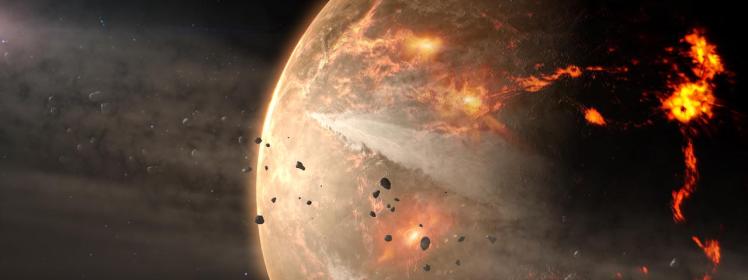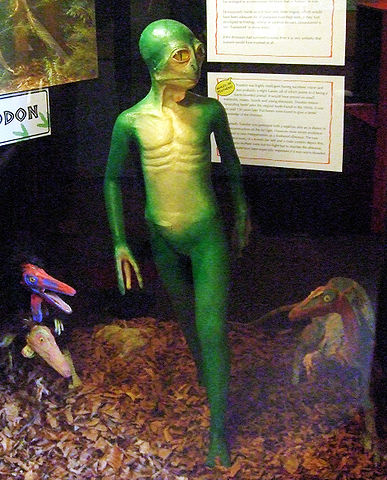There have been quite a few stories recently of ‘the discovery of the century’ – a huge fossil treasure trove in North Dakota dating back 65 million years to when an asteroid hit the earth and caused the mass extinction of dinosaurs.
The researchers studying the fossils say they are a snapshot of that day, which is evidence that has been missing of the immediate hours and days following the impact. Fish are frozen in rock after being inundated by an inland surge of material, glass beads lodged in their gills – molten debris that rained down after the impact. Dinosaur footprints found at the site is “definite proof that the dinosaurs were alive and kicking at the time of impact … They were running around, chasing each other,” says one of the study’s authors.
This new evidence, say the authors, proves that it was an asteroid and not volcanic activity that caused the extinction event – a theory that had been put forward by other scientists.
What happened?

All those millions of years ago when half to three-quarters of the world’s species went extinct and the Cretaceous age came to a very abrupt end either a giant ball of rock smacked into Mexico or volcanoes chugged up a lot of ash. Either of these threw a huge of material into the atmosphere, blocking the sun, killing plants and destroying food chains.
The asteroid impact camp says that the presence of iridium in the layer of rock from that period matches concentrations found in asteroids, whilst the volcanists (yes I invented this) say this came from the magma spewed from eruptions on Earth.
If we roll with the asteroid theory, the idea is that a 9km wide asteroid hit Earth, creating the Yucatán Peninsula crater. This impact caused something around a 100 million megaton blast with a core of superheated plasma reaching 10,000 degrees. Though the explosion would have only taken a few minutes, 1,000km/h winds would have radiated outwards to a radius of 1,500km, shredding everything in its path. Debris would then have rained down across a wider area, up to 300m thick in some places, whilst tsunamis estimated somewhere between 100 and 300m high inundated land across the Americas and a size 10 earthquake caused huge landslides on the sea floor.
Debris falling back to earth would have burned in the atmosphere as well, causing wildfires as the atmosphere heated up and leading to sulphuric acid rain that fell for a decade. The blocking of sunlight would initially made temperatures drop for 5-10 years before greenhouse gases caused thousands of years of global warming.
Sounds like a complete and utter mess. If dinosaurs were wiped out though, how are we all here?
Lucky strike?

If the T. rex was still lurking in the bushes, would humans even exist? Maybe not. It was after the demise of dinosaurs that mammals became the dominant vertebrates on land. Apparently, mammals in burrows or in water would have been shielded from the heat of the impact and then their more adaptable diets allowed them to work around the disruption of food chains.
In a BBC programme a while ago called The Day the Dinosaurs Died, it was argued that if the asteroid had hit a bit earlier or later, it would have crashed into the deep sea either side of Mexico, which would have absorbed a lot of the impact and reduced the amount of material ejected into the atmosphere. Potentially preventing mass extinction. So, would mammals have ever developed enough to evolve into the human race?
Some scientists theorise that dinos were dying out anyway and cooling global temperatures would have benefited the more adaptable mammal species. Others say there was still a lot of evolutionary potential and they would have continued to be the dominate life on the planet, but maybe decreased in size as plant diets moved towards flowering plants.
Mammals were still ‘marginal, shadowy little creatures’ says Stephen Brusatte of the University of Edinburgh in this BBC Future article, who were diverse but typically small and restricted to specific niches. “It was only the shock of the asteroid knocking off the incumbent dinosaurs that allowed them to break free,” he says.

Or could the dinosaurs have developed in intelligence to become weird-looking lizard people? This is the basis of a 1982 thought experiment from paleontologist Dale Russell, who was curator of vertebrate fossils at the National Museum of Canada in Ottawa. He theorised that a ‘dinosauroid’ could have evolved that had a human shape but huge eyes. Roundly rejected by others for being ‘suspiciously human’, the models created to illustrate the creature are nonetheless disturbing.
Maybe we could have ended up in a real-life Jurassic Park where we lived alongside the remnants of the dinosaurs. Then again, maybe this will happen one day anyway, with reports of gene editing of chickens already taking place to give them teeth and other dinosaur-like characteristics.
“Of course birds are dinosaurs,” palaeontologist Jack Horner told People magazine a few years ago, “so we just need to fix them so they look a little more like a dinosaur.”
Yeah, definitely couldn’t go wrong.
Find this interesting? Check out my post on bringing back the woolly mammoth!